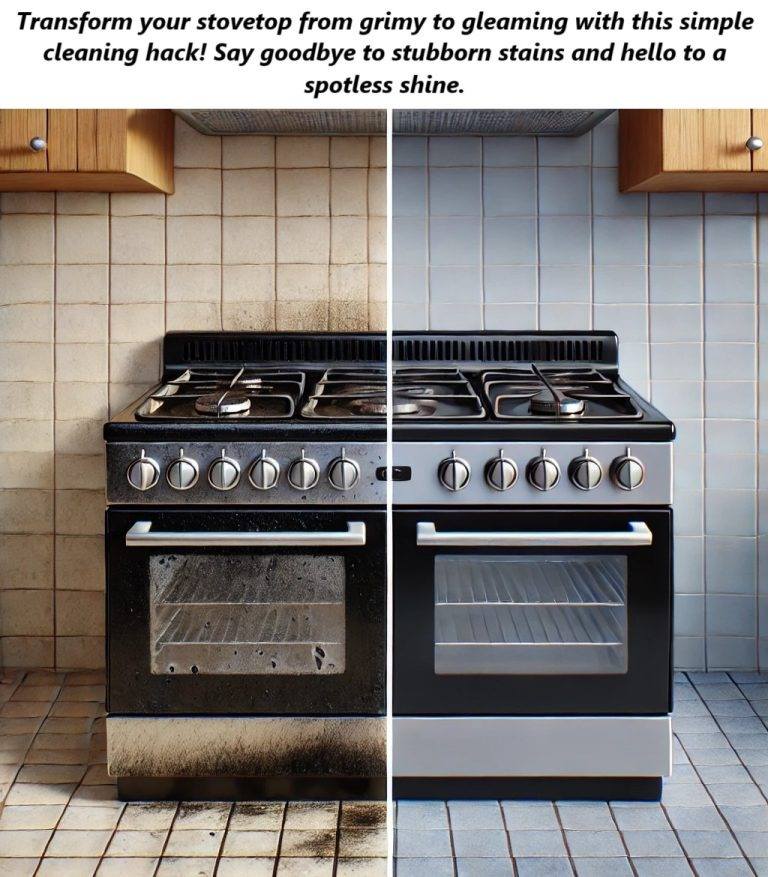ADVERTISEMENT
### Step-by-Step Guide to Cleaning Your Stovetop
#### 1. **Turn Off and Cool Down the Stove**
Safety first! Make sure your stovetop is turned off and completely cool before you begin cleaning. You don’t want to burn yourself or damage the appliance with sudden temperature changes.
#### 2. **Remove Grates and Burner Caps (for Gas Stoves)**
If you have a gas stove, start by removing the **grates** and **burner caps**. These parts can accumulate grease and food bits that need a more thorough cleaning.
– For greasy or burnt-on buildup, soak the grates and caps in a mixture of **warm water** and **dish soap** for about 15-20 minutes. If there’s stubborn grease, use a scrub brush or non-abrasive sponge to scrub them clean.
#### 3. **Clean the Surface of the Stovetop**
For electric and ceramic stovetops, gently wipe the surface with a **damp cloth** to remove any loose crumbs or debris. For tougher buildup, a **cleaning solution** of **dish soap** and **warm water** works wonders. Here’s how:
– **Gas stovetops**: Spray the stovetop surface lightly with **white vinegar** to help break down grease and grime. You can follow up with a little **baking soda** for added abrasiveness. Let the solution sit for a few minutes before scrubbing.
– **Electric or ceramic stovetops**: If you’re dealing with tough stains or sticky spots, sprinkle **baking soda** directly onto the surface, then spray with **white vinegar**. The combination of vinegar and baking soda will foam up and help lift away grime.
#### 4. **Scrub Away the Grime**
For stubborn spots, use a **non-abrasive scrub brush** or sponge to scrub the stovetop. Be gentle, especially on ceramic cooktops, to avoid scratching the surface. For tougher grease or stains, a **plastic spatula** can help gently scrape off buildup without causing damage.
For gas stoves, use a scrub brush to tackle any leftover grease around the burners. Make sure to clean both the stovetop and the area surrounding the burners.
#### 5. **Tackle the Burners (for Gas Stovetops)**
Once the grates and burner caps have soaked and softened, scrub them thoroughly with a sponge or brush. If there are stubborn spots, you can use **baking soda** to remove the last traces of grease.
After scrubbing, rinse off the soap and wipe them down with a clean, dry cloth before putting them back on the stovetop.
#### 6. **Wipe Down the Stovetop**
Once the stovetop surface and burners are clean, wipe down the entire area with a **microfiber cloth** to remove any residue. Make sure to dry it completely to prevent watermarks or streaks.
#### 7. **Polish the Stovetop (Optional)**
For an extra gleaming finish, you can use a **commercial stovetop cleaner** or a few drops of **olive oil** on a soft cloth. Gently rub the oil into the surface to restore shine and help prevent future buildup.
### Tips for Maintaining a Clean Stovetop
Now that your stovetop is gleaming, you’ll want to keep it looking like new. Here are a few tips for maintaining your stovetop’s shine:
– **Clean spills immediately**: The sooner you wipe up spills, the less likely they are to become hardened stains. It’s easier to wipe up liquid spills right away.
– **Deep clean weekly**: Give your stovetop a deeper clean once a week, including removing the grates and burner caps for a thorough scrub.
– **Use splatter guards**: Consider using splatter guards when cooking to minimize grease buildup and food splatters on the surface.
– **Avoid harsh chemicals**: Stick to natural cleaners like vinegar, baking soda, and dish soap whenever possible to avoid damaging your stovetop with harsh chemicals.
– **Protect the surface**: For ceramic cooktops, consider using a protective cleaner that forms a thin protective layer over the surface to keep stains at bay.
### Bonus Tip: How to Clean a Dirty Oven
If your oven is also in need of a good cleaning, try using a **baking soda paste** (mix baking soda and water to form a thick paste). Apply it to the interior walls of your oven, let it sit for 12 hours, then wipe it down with a damp cloth. This will help lift grease and burnt-on food from the oven walls without harsh chemicals.
### Final Thoughts
Cleaning your stovetop doesn’t have to be a difficult or time-consuming task. By using the right tools and techniques, you can restore your stovetop to its gleaming, like-new condition. Regular cleaning will not only improve the appearance of your stovetop but also extend its lifespan and help maintain its efficiency.
With this step-by-step guide, your stovetop will be sparkling clean and ready for your next culinary adventure. So, roll up your sleeves, grab those cleaning supplies, and give your stovetop the care it deserves!
ADVERTISEMENT
